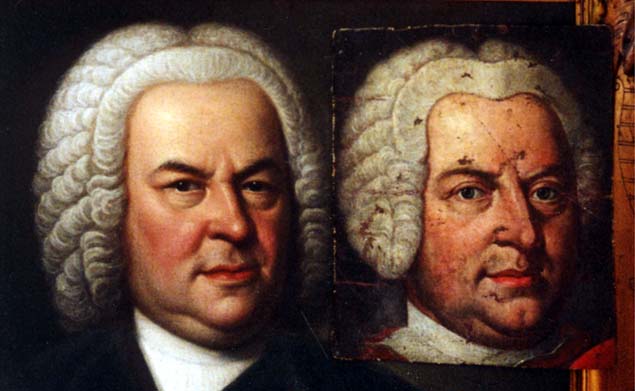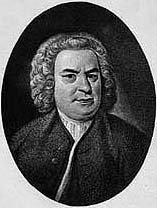The Critical Discographies from Choral Music On Records - Mass in B Minor Pages at the Teri Noel Towe Home Pages
Johann Sebastian Bach
The Critical Discographies from Choral Music On Records
This remarkable photograph is not a computer generated composite; the original of the Weydenhammer Portrait Fragment, all that
remains of the portrait of Johann Sebastian Bach that belonged to his pupil Johann Christian Kittel, is resting gently on the surface
of the original of the 1748 Elias Gottlob Haussmann Portrait of Johann Sebastian Bach.

1748 Elias Gottlob Haussmann Portrait, Courtesy of William H. Scheide, Princeton, New Jersey
Weydenhammer Portrait Fragment, ca. 1733, Artist Unknown, Courtesy of the Weydenhammer Descendants
Photograph by Teri Noel Towe
©Teri Noel Towe, 2001, All Rights Reserved
The Critical Discographies from Choral Music On Records
Mass in B Minor, BWV 232
Mass in B Minor, BWV 232
The Herbert von Karajan Recordings
In 1950, the bicentenary of the death of Sebastian Bach was commemorated by a divided Germany and by a world just beginning to
recover from the horrors and devastation of the Second World War. Two live performances of the Mass from that historic year
have found their way to commercial recordings.
The first of these performances was given in the Musikvereinsaal in Vienna in 1950, at the International Bach Festival. [8] It is the
first, and the most exhilarating, of four recorded performances of the Mass under the direction of Herbert von Karajan that have so
far been released commercially. While by no means competitive with the studio recordings, this fascinating document preserves
Karajan's view of the Mass at its most colorful and "operatic". Grand ritards, rich dynamics and expression, powerful
interpretations from five world class soloists (including Kathleen Ferrier who otherwise never recorded the alto solos and duets
from the Mass in their entirety), and complete commitment from chorus and orchestra (except for a tentative hornist who sounds
absolutely terrified in the "Quoniam"!) make this dramatic "Furtwängleresque" reading of the Mass a thrilling listening experience,
the wildly variable and often muddy sound not withstanding.
Five years later, Karajan made the first of his two commercial recordings of the Mass. [9] Once again, the locale was Vienna, but
the only "repeater" from the 1950 concert performance is soprano Elisabeth Schwarzkopf, who once more acquits herself
magnificently in the first soprano's three duets. Marga Höffgen is cool and clear in the alto solos including a particularly slow
"Agnus Dei", but Nicolai Gedda sounds strangely uninvolved in the painfully languid "Benedictus". Karajan's interpretation is less
operatic and less dramatic than it was five years earlier, but this incisive and persuasive reading remains a satisfying one, one of the
best in the "modern" style. Although a monaural recording, the sound is more natural and better focussed than in the later DGG
stereo version.
Karajan presented the B Minor Mass at the Salzburg Festival in 1961, and the performance recorded on August 20 of that year for
later broadcast was released commercially in Italy in the mid '80s. [10] Again available only in monaural sound, the performance
features an especially fine battalion of soloists. Leontyne Price sings the first soprano's music with the power and conviction of a
Verdi heroine (or, at least, a soloist in the "Manzoni" Requiem!); Christa Ludwig's molten sound is powerful in the second soprano
and alto rôles; and Nicolai Gedda is radiant, sensitive, and effortless in all of the tenor solos, including the "Benedictus". Walter
Berry, alas, did not have one of his best days; his singing in the "Quoniam: is mildly tentative and uncommitted; Gérard Souzay's
glistening, light baritone is perfect for the "Et in spiritum sanctum", but his diction is at times unpardonably mushy for a lieder singer
of his stature. Particularly in the arias and duets, Karajan's tempos to be brisker than in either of the two commercial recordings.
In his second commercial recording of the Mass, published in 1974, Karajan coddles and overinterprets the music. [11] It is not,
however, a case of familiarity breeding contempt; rather, it is a case of sparing the rod and spoiling the child. Karajan's genuine
affection and profound empathy for the Mass has begotten an interpretation that is too solicitous, too respectful, and too loving.
This impression is reinforced by the sonic aura of the recording, which is blemished by the bizarre artificial sound and balances that
infect so many of his later recordings; the chorus is distant within the ensemble, and the strings are peculiarly louder than the brass.
The arias are very slow in the main. Christa Ludwig sings with a reserved drama and wonderful secure tone, particularly in the
"Agnus Dei", and Peter Schreier responds marvelously to the challenge posed by an incredibly slow tempo in the "Benedictus".
Please click here to advance to Page 5 - The Recordings in the Neo-Baroque Leipzig Style.
Please click here to visit the Endnotes Page.
Please click here to visit the Alphabetical Discography Page.
Please click here to return to the Critical Discographies from Choral Music On Records Main Page.
Please click on  to return to the Johann Sebastian Bach Index Page.
to return to the Johann Sebastian Bach Index Page.
Please click on the  to return to the Teri Noel Towe Welcome Page.
to return to the Teri Noel Towe Welcome Page.
teritowe@alumni.Princeton.EDU
Copyright, Teri Noel Towe, 1989, 1997, 2001
All Rights Reserved
The The Critical Discographies from Choral Music On Records - Mass in B Minor Pages at the Teri Noel Towe Home Pages
are PPP Free web pages.

The The Critical Discographies from Choral Music On Records - Mass in B Minor Pages at the Teri Noel Towe Home Pages
have received the HIP Woolly Mammoth Stamp of Approval from The HIP-ocrisy Home Page.